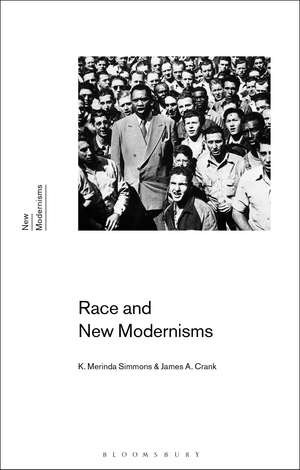Race and New Modernisms: New Modernisms
Autor Professor K. Merinda Simmons, Dr James A. Cranken Limba Engleză Paperback – 4 sep 2019
| Toate formatele și edițiile | Preț | Express |
|---|---|---|
| Paperback (1) | 171.39 lei 22-36 zile | |
| Bloomsbury Publishing – 4 sep 2019 | 171.39 lei 22-36 zile | |
| Hardback (1) | 496.21 lei 43-57 zile | |
| Bloomsbury Publishing – 4 sep 2019 | 496.21 lei 43-57 zile |
Preț: 171.39 lei
Preț vechi: 199.45 lei
-14% Nou
Puncte Express: 257
Preț estimativ în valută:
32.81€ • 35.65$ • 27.57£
32.81€ • 35.65$ • 27.57£
Carte disponibilă
Livrare economică 31 martie-14 aprilie
Preluare comenzi: 021 569.72.76
Specificații
ISBN-13: 9781350030398
ISBN-10: 1350030392
Pagini: 224
Dimensiuni: 138 x 216 x 16 mm
Greutate: 0.3 kg
Editura: Bloomsbury Publishing
Colecția Bloomsbury Academic
Seria New Modernisms
Locul publicării:London, United Kingdom
ISBN-10: 1350030392
Pagini: 224
Dimensiuni: 138 x 216 x 16 mm
Greutate: 0.3 kg
Editura: Bloomsbury Publishing
Colecția Bloomsbury Academic
Seria New Modernisms
Locul publicării:London, United Kingdom
Caracteristici
Explores key case studies on modernism and race, including the Harlem Renaissance, colonialism in the Caribbean and Hemingway in Cuba
Notă biografică
James A. Crank is Associate Professor at the University of Alabama, USA. His books include Understanding Sam Shepard (2012), New Approaches to Gone with the Wind (2015), and Understanding Randall Kenan (2019). K. Merinda Simmons is Associate Professor at the University of Alabama, USA. Her books include Changing the Subject: Writing Women Across the African Diaspora (2014) and The Trouble with Post-Blackness (co-edited with Houston A. Baker, Jr., 2015).
Cuprins
Acknowledgements Introduction: Coming to Terms: Identifying Race and New ModernismsCh. 1: Lost Languages: Ex-Pat Primitivism and European Modernity in TranslationCh. 2: The Birth of Many Nations: Imperial Modernisms in the CaribbeanCh. 3: Re-Turning South (Again): Renaissances and RegionalismCh. 4: The Art of Ideology: Black Aesthetics and Politics in Modernist HarlemCh. 5: Selling Otherness: Racial Performance and Modernist MarketingCoda: Who's the MatterWorks CitedWorks Consulted
Recenzii
Race and New Modernisms is a quick and handy introduction to the last 25 years of modernist scholarship, but perhaps its real value will serve in announcing that we're entering a new, as yet unnamed era in modernist studies.
A tour de force! Race and New Modernisms succeeds in circuiting race through its primitivizing and exoticizing deployment in canonical modernism to a series of connected sites (the Caribbean, the US South, Harlem, and Paris) and all the while presenting a self-reflexive, savvy interrogation of the ways in which we "know" race. They demonstrate that modernism could not have existed without its racial identifications, not only in its art forms, but also in its rhetoric of nationhood, civilization, cosmopolitanism, and otherness. Even better, they show how race is not an inert or self-evident thing, but a complex and shifting system of social organization that is struggled over at every turn, from the beginnings of modernism until today. This critical primer will be indispensable for teaching and research on race and modernism for years to come.
This is a lucid guide to the complex relationship between conceptions of race and the diverse cultures of modernism. Simmons and Crank invite readers to consider multiple aspects of race in the early 20th century, demonstrating that any understanding of regional, national, and global modernisms is inseparable from an understanding of racial discourses.
K. Merinda Simmons and James A. Crank have written a probing and valuable book ... [it] rewards a close reading and succeeds in establishing a basis for both scholars and lay readers to rethink common assumptions about both modernism and writings about race.
A tour de force! Race and New Modernisms succeeds in circuiting race through its primitivizing and exoticizing deployment in canonical modernism to a series of connected sites (the Caribbean, the US South, Harlem, and Paris) and all the while presenting a self-reflexive, savvy interrogation of the ways in which we "know" race. They demonstrate that modernism could not have existed without its racial identifications, not only in its art forms, but also in its rhetoric of nationhood, civilization, cosmopolitanism, and otherness. Even better, they show how race is not an inert or self-evident thing, but a complex and shifting system of social organization that is struggled over at every turn, from the beginnings of modernism until today. This critical primer will be indispensable for teaching and research on race and modernism for years to come.
This is a lucid guide to the complex relationship between conceptions of race and the diverse cultures of modernism. Simmons and Crank invite readers to consider multiple aspects of race in the early 20th century, demonstrating that any understanding of regional, national, and global modernisms is inseparable from an understanding of racial discourses.
K. Merinda Simmons and James A. Crank have written a probing and valuable book ... [it] rewards a close reading and succeeds in establishing a basis for both scholars and lay readers to rethink common assumptions about both modernism and writings about race.









